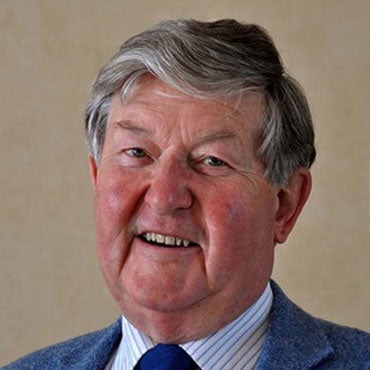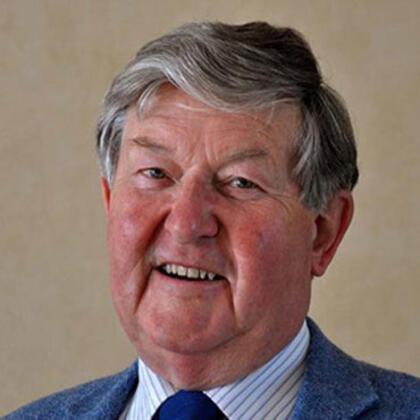A Little Light Relief
Share
- Details
- Transcript
- Audio
- Downloads
- Extra Reading
Light, particularly sunlight, has always occupied a mystical power and is commonly held to bestow good health upon recipients of its rays. That there is both truth and fallacy in such beliefs will be demonstrated as the science of photo-medicine is dealt with from a chemist’s point of view. The subject encompasses the effects of light on the skin, diagnostic uses of light, and therapeutic aspects, with a brief consideration of the harmful effects of solar radiation. The lecture will be illustrated with demonstrations. No prior knowledge of chemistry or science is necessary.
Download Transcript
2 November 2016
A Little Light Relief
Professor David Phillips
Photochemistry has had an impact on society in a wide variety of ways, including the important topic of photomedicine. We describe here a very brief history of this subject, including current uses of light in medicine1,2, before turning to photodynamic therapy, and speculations about future directions in PDT. The father of modern photo-medicine was Neils Finsen, the Danish physician who in the late 19th century used ultra-violet light to cure the facial sores [lupus vulgaris] exhibited by sufferers from tuberculosis. For this at first sight relatively trivial advance, he was awarded one of the first Nobel Prizes for Medicine in 1903, and thus brought to the attention of the world the potential medical uses of light. In the 20th century, and particularly since the invention of the laser in 1960, light has played an increasing role in medical matters3. The present applications can be summarised briefly as follows:
[1] The effects of light upon the skin;
[2] The uses of light in diagnosis, including cell-sorting and fluorescence microscopy;
[3] Therapeutic treatments using non-laser light;
[4] Uses of lasers.
1/ Skin
The skin is the heaviest and most accessible organ of the body, and thus light can have dramatic effects, some harmful, some beneficial. The obvious beneficial effect is the synthesis by sunlight of Vitamin D, which boosts that taken in the diet. Too little Vitamin D results in bone deformation, [rickets], due to the role of Vitamin D in the calcium uptake process. Rickets was very common in Victorian Britain, and at the same time was virtually unknown in India reflecting the very different extent of solar inputs in the two locations. Vitamin D deficiency has become quite common again amongst populations in northern latitudes, probably in part due to publicity about skin cancer leading to reduced exposure of population to sunlight; however it is easily detected, and treated using dietary augmentation. There is also some correlation between Vitamin D deficiency and multiple sclerosis.
The negative aspects of light upon the skin are premature ageing, and skin cancers. Skin cells are produced in the basal layer [basal cells] and travel towards the surface [squamous cells], becoming less globular, until they reach the surface [28 days after cell birth, in a normal human], where they are flat dead flakes, which are lost to the environment [much household dust is the dead skin cells of inhabitants]. Some cells have melanin pigment [melanocytes]. Tanning represents the reaction of the skin to the ultraviolet threat, and thus should be treated with caution, i.e. the use of sun-blocking and attenuating agents [but receiving some sunlight is beneficial, cf. Vitamin D production]. All cell types can become malignant under the influence of ultraviolet light. Basal cell and squamous cell carcinomas do not in general metastasise, so can be treated locally, usually surgically. Malignant melanoma undergoes rapid metastasis, and should be treated immediately to avoid development of secondary, and often fatal, metastatic cancers in other parts of the body.
2/ Light in diagnosis
Luminescence, both chemiluminescence and fluorescence is in widespread use for immunoassay i.e., the identification of antigens in the body which may be precursors to disease. Immunometric assay uses a combination of two antibodies: one immobilised, which is specific to the antigen being tested for, the second, the labelled antibody, which binds to a different site on the antigen. When a fluid sample [e.g. blood, urine] is tested, if the antigen is present it binds to the immobilised antibody, and this permits the labelled antibody to bind, i.e. the system is positive-reading. If the antigen is absent, the second antibody cannot bind, and so there is no luminescent signal. The signal can be activated by addition of peroxide in the case of chemiluminescent labels; by light for fluorescent labels. Examples of the use of immunoassay might be the testing for pregnancy at early stages by seeking the hormone human chorionic gonadotrophin, or testing for the HIV virus, but the technique is ubiquitous.
Fluorescence microscopy has become a universally used tool in biology and medicine, particularly confocal microscopy, and latterly fluorescence lifetime imaging microscopy, FLIM, 3-6 and, most importantly, single molecule microscopy. FLIM systems are usually based on femtosecond lasers, and a pioneering wide-field instrument developed by colleagues in Imperial College has been used in many biological studies, including studies on the immune system7,8, using Green Fluorescent Protein, [GFP] labelling, for which the 2008 Nobel Prize in Chemistry was awarded to Shimomura, Chalfie and Tsien. The major histocompatibility complex, [MHC], presents cell proteins on the surface of cells. The primary interrogation of proteins on cell surfaces is carried out by T-cells; alien proteins result in the destruction of the cell by the immune system. Some viruses are able to remove the MHC, thus alien proteins are not presented, and the T-cells do not recognise these cells as infected. However, natural killer cells interact with the MHC directly 9,10, and its absence then triggers the destruction of the cell. A further variable in the study of cells is the local viscosity, which is believed to exert considerable physiological effect. Viscosity can be probed directly by monitoring the fluorescence anisotropy decay in living cells. An alternative to this direct measurement is the use of probe molecules, where a considerable dependence upon the fluorescence yield and decay time upon local viscosity is exhibited. BODIPY molecules are good examples of this type of probe.10
The future of microscopy, in addition to the wider use of fluorescence lifetime imaging14,15 and methods which create images of resolution below the wavelength of the light used, such as Stimulated Emission Depletion [STED]11-18 are forms of nanoscopy. These and related techniques typically can create images of the order of an order of magnitude higher in resolution than the wavelength of light, for which the 2015 Nobel Prize in Chemistry was awarded to Betzig, Hell, and Moerner.
3/ Therapy
Uses of non-laser light in therapy are described below
i Neonatal jaundice
Since the late 1950s, neonatal jaundice has been treated using blue light. The condition arises in premature infants, and those born with minor liver malfunction, which is very common. Breakdown of red blood cells in the body produces copious amounts of the yellow porphyrinic pigment bilirubin, which is water insoluble, but dissolves readily in fat. Normal adults have an enzyme in the liver and bile which converts this fat- soluble form of bilirubin to a water soluble form, which permits excretion of the bilirubin in urine and stools. Before birth, the infant does not have the enzyme, since it cannot excrete, but upon birth, the enzyme usually develops with a day or so. For those premature infants the development of the enzyme may take much longer, and the fat soluble bilirubin is stored in the skin, hence the jaundice. A chance observation in the UK in the 1950s of a jaundiced infant in sunlight who became bleached led to the widespread use of visible [blue] light to treat the condition. The mechanism was widely disputed until recently, but the consensus view now is that the bilirubin molecule under the influence of light undergoes a photochemical cis-trans isomerisation about one of the double bonds in the structure. This mechanism is supported by the fact that the photochemical reaction is very fast, thus a concerted process.
ii Psoriasis
In the various forms of psoriasis, the basal layer of the skin overproduces skin cells, such that when they travel to the surface they are still viable. The treatment is to use a sensitising agent a fumocoumarin, [psoralen], which absorbs near ultraviolet light and destroys the adjacent skin tissue The term used for the therapy is the PUVA treatment. The treatment does not address the cause of the disease, merely treats the symptom, but affords much relief to patients.
iii Vitiligo
The same treatment can be used to treat vitiligo, the loss of melanin in pigmented skin cells, resulting in white patches. These are not much of a problem in Caucasian skins, but are very disfiguring in pigmented skins.
4/ Uses of lasers
The effects of laser light upon human tissue depend upon the fluence, and the presence or absence of a sensitiser. At low levels, <4Wcm -2, the effect is to stimulate development of cells, a process used in some countries to assist wound healing. At higher energies, the effects are the opposite, to slow down cell growth or even destroy tissue. Thus at light levels of 40 W cm-2, the light alone has little effect, but in the presence of sensitisers, can lead to tissue destruction, one form of which is termed photodynamic therapy [PDT], discussed below in detail. At 400 W cm-2, photo-thermal effects dominate, with sealing of blood vessels a desirable goal [photocoagulation], and for very powerful lasers, >4000 W cm-2, tissue ablation [disappearance] occurs. The precise details of these processes are dependent upon the wavelength of the laser, and whether pulsed or continuous. Present day medical uses include:
[i] Laser surgery, the use of powerful lasers, usually an IR YAG laser, to cut tissue. The laser cauterises as it cuts, thus leading to bloodless surgery.
[ii] Eye treatments, particularly laser eyesight corrective procedures. Here an ablating ultraviolet laser, usually an excimer, short wavelength source, is used to reshape the cornea of patients with defective vision, thus permitting the lens to focus visible light accurately upon the retina. The laser is chosen since it has an extremely short penetration distance, thus is not a danger to the retina. Such treatments are generally extremely effective, and for most patients painless.
[iii] Photodynamic Therapy, discussed below.
5/ Photodynamic therapy
Photodynamic therapy (PDT) is a minimally invasive procedure used in treating a range of cancerous diseases,19 infections20 and, recently, in ophthalmology to treat the wet form of age-related macular degeneration (AMD).21 The photodynamic action relies on the simultaneous interaction between a non-toxic photosensitiser molecule, visible light and molecular oxygen, offering dual selectivity through preferential uptake of the photosensitiser by diseased cells and the selective application of light. Following activation with visible light of the appropriate wavelength, the photosensitiser generates reactive oxygen species (ROS), primarily the reactive singlet state of molecular oxygen, called singlet oxygen, through the energy transfer to the ground state triplet oxygen. Other photochemical products of energy and/or electron transfer include radicals, e.g. superoxide anion O22- and the hydroxyl radical OH. Production of these short-lived species within biological tissues leads to localised cell death via irreversible damage to cellular components such as proteins, lipids and DNA. The mechanism of PDT action is usually taken to be due to the formation by energy transfer of singlet oxygen although electron transfer processes may play a role22-24 Thus diffuse reflectance studies on the effect of di-sulfonated aluminium phthalocyanine photosensitisers on various bacteria [S. mutans, P. gingivalis, and E. coli, and the fungus Candida albicans] revealed the spectral signature of the radical anion of the sensitisers clearly implicating electron transfer.22,23 Photofrin, a first-generation photosensitiser,has been used to treat advanced and early stage lung cancers, gastric cancers, oesophagal adenocarcinoma, cervical and bladder cancers.25,26 . Photofrin nevertheless has a number of limitations such as prolonged skin photosensitivity and poor absorption in the red, and more recent efforts have concentrated on improved second generation photosensitisers largely based on modified tetrapyrrolic macrocyles (porphyrinoids) with excellent absorption profiles at longer wavelengths and including both naturally derived and synthetic molecules, such as Photosens [a trisulfonated phthalocyanine]27; Foscan [5,10,15-tetrakis-{m-hydroxyphenyl}chlorin];28,29 Visudyne, [a benzoporphyrin derivative, BPD], largely used to treat wet-form age-related macular degeneration29,30,as is Vertepofyrin31; Levulan [5-aminolaevulinic acid],29,30 which undergoes biosynthetic transformation to protoporphyrin IX, and other chlorins, bacteriochlorins, benzoporphyrin derivatives and naphthalocyanines. A recent count showed that there are in excess of 1450 molecules identified in the literature as being potentially of use in PDT. Very few of these will be used for this purpose, due to the very high cost of introduction into the clinic associated with Phase I, II and III clinical trials It is thus the belief of this author that choice of new photosensitisers will be based upon their biological properties rather than photochemical, and that key to this is the targeting of the sensitisers to the tissue ;improving this by at least an order of magnitude could reduce dramatically the dosage required for the PDT effect, and reduce considerably side effects such as skin sensitivity. The principal means to achieve targeting include:
[i] Whole antibodies;
[ii] Monoclonal antibody fragments; 32,33
[iii] Peptides, sugars, folic acid;34-361
[iv]Multifunctional nanoparticles37,38;
[v] Spatial targeting using two-photon excitation39-41.
Our own work has concentrated upon single chain monoclonal antibody fragments on which typically eight to ten sensitisers per monoclonal can be achieved, without causing the aggregation which plagues free sensitisers, leading to loss of efficiency by self-quenching. The sensitisers are attached to the monoclonal antibody fragments via a peptide linkage to the lysine amino acids in the monoclonal. A typical result of this type of targeted PDT shows that a thrice-repeated light treatment on mice bearing a human carcinoma is completely successful in the case of the monoclonal antibody-sensitiser conjugate in eradicating the tumour, whereas the free sensitiser merely arrests growth for a time before re-growth occurs. The second approach to targeting used in the author’s laboratories is that of two-photon excitation of porphyrin dimer sensitisers produced in Professor Harry Anderson’s laboratories in Oxford44-46. Although the one-photon effect is poorer in these sensitisers in comparison with the commercial sensitiser Visudyne, in two photon excitation, the porphyrin dimers are much more effective.44-45,46 Two-photon excitation has the advantage of using red or infra-red light, which penetrates tissue much more readily that visible light needed for one-photon excitation. The principle has been demonstrated by the two-photon PDT sealing of blood vessels in mice. Two-photon excitation has the advantage of using red or infra-red light, which penetrates tissue much more readily that visible light needed for one-photon excitation. The two-photon process may thus have some potential as a means of achieving spatial selectivity in PDT, though it must be admitted that there are practical difficulties.
Conclusions
What is the future of photomedicine? It is of course difficult to give a long perspective. Finsen could clearly not have foreseen the widespread use of lasers in modern medicine. Some potential developments are, however, obvious. It is clear that imaging and biological studies using fluorescence nanoscopy [and phosphorescence] will reveal details of the cellular processes, both intracellular and between cells, which could transform the understanding of the biology of that most complex of entities, and this in turn can lead to step functions in the understanding and treatment of human disease. The photophysical processes which will be utilised in aiding such microscopy studies will be changes in fluorescence spectra, decay times, and anisotropy affected by refractive index, polarity, pH, viscosity, quenching, and will include imaging of singlet oxygen and other applications of transient spectroscopy. In the direct treatment of patients, lasers will continue to develop, and surgery, eye correction, and microsurgical techniques will surely be improved. It is the belief and hope of this author that targeted PDT by all the means listed will improve vastly the efficiency of the technique, and will lead in the near future and beyond, it is hoped, to an accelerating usage by the medical profession.
References
1 ‘The Science of Photomedicine’ ,eds J.D.Regan and J.A.Parrish, Plenum Press, NY and London, 1982.
2 D. Phillips, ‘ Light Relief: photochemistry and medicine’ , Photochem.Photobiol.
Sci 2010, 9, 1589-1596
3 Klaus Suhling, Paul M. W. French and David Phillips, ‘Time-resolved fluorescence microscopy, Photochem. Photobiol. Sci., 2005, 4, 13–22.
4 J. Siegel, K. Suhling, S. Leveque-Fort, S. E. D. Webb, D. M. Davis, D. Phillips, P. M. W. French and Y. Sabharwal,’ Wide-field time-resolved anisotropy imaging TRFAIM; Imaging the mobility of a fluorophore’, Rev. Sci. Instrum., 2003, 74, 182–192.
5 D. Elson, S. E. D. Webb, J. Siegel, K. Suhling, D. M. David, J. Lever, D. Phillips, A. Wallace and P. M. W. French, ‘Biomedical applications of fluorescence lifetime imaging’, Opt. Photonics News, 2002, 13, 26– 30.
6 K. Suhling, J. Siegel, D. Phillips, P. M. W. French, S. Leveque-Fort, S. E. D. Webb and D. M. Davis, ‘Imaging the environment of Green Fluorescent Protein, GFP’, Biophys. J., 2002, 83, 3589–3595.
7 B. Treanor, P. M. P. Lanigan, K. Suhling, T. Schreiber, I. Munro, M. A. A. Neil, D. Phillips, D. M. Davis and P. M. W. French, ‘Imaging fluorescence lifetime heterogeneity applied to GFP-tagged MHC protein at an immunological synapse’, J. Microsc., 2005, 217, 36–43.
8 Bebhin Treanor, Peter M. P. Lanigan, Sunil Kumar, Chris Dunsby, Ian Munro, Egidijus Auksorius, Fiona J. Culley, Marco A. Purbhoo, David Phillips, Mark A. A. Neil, Deborah N. Burshtyn, Paul M. W. French and Daniel M. Davis, ‘Microclusters of inhibitory killer immunoglobulin-like receptor signalling at Natural Killer Cell immunological synapses’, J. Cell Biol., 2006, 174, 153– 161.
9 M.K.Kuimova, S.W.Botchway, A.W.Parker, M.Balaz, H.A.Collins, H.L.Anderson, K.Suhling and P.R.Ogilby,’Imaging cellular viscosity of a single cell during photo-induced cell death’, Nat. Chem., 2009, 1, 69–73.
10 M. K. Kuimova, G. Yahioglu, J. A. Levitt and K. Suhling, ‘Molecular rotor measures viscosity via fluorescence lifetime imaging’ ,J.Am.Chem. Soc., 2008, 130, 6672–6673.
11 T. A. Klar, M. Dyba and S. W. Hell, ‘Stimulated emission depletion microscopy with an offset depleting beam’, Appl. Phys. Lett., 2001, 78, 393–396.
12 T. A. Klar, E. Engel and S. W. Hell, ‘Breaking Abbe’s diffraction resolution limit in fluorescence microscopy with stimulated emission depletion beams of various shapes’, Phys. Rev. E: Stat., Nonlinear, Soft Matter Phys., 2001, 64, 0066613.
13 S. Habuchi, R. Ando, P. Dedecker, W. Verheijen, H. Mizano, A. Miyawaki and J. Hofkens, ‘Reversible single-molecule photoswitching in the GFP-like fluorescent protein Dronpa’, Proc. Natl. Acad. Sci. USA 2005, 102, 9511–9516.
14 P. Dedecker and J. Hofkens,’ Single molecule spectroscopy; Caught in the trap’, Nat. Chem., 2010, 2, 157–159.
15 M. Gudmand, S. Rocha, N. S. Hatzakis, K. Peneva, K. Mullen, D. Stamou,H.Uji-I,J.Hofkens,T.Bjornholm and T.Heimburg,’Influence of lipid heterogeneity and phase behaviour onphospholipase A2 action at the single molecule level’, Biophys. J., 2010, 98, 1873–1882.
16 C. Forthmann, P. Tinnefeld, S. W. Hell and M. Sauer, Single Molecule STED miscroscopy with photo-labile organic chromophores, Small, 2010, 6, 1379–1384.
17 L. Kastrup, D. Wildanger, B. Rankin and S. W. Hell, Stimulated emission depletion microscopy with compact light sources, in Nanoscopy and Multidimensional Fluorescence Microscopy, ed. A. Diaspro, Chapman and Hall/CRC, Boca Raton, 2010, pp. 1–13.
18 D. Wildanger, E. Rittweger, L. Kastrup and S. W. Hell, ‘STED Microscopy with a supercontinuum laser source’, Opt. Express, 2008, 16, 9614–9621.
19 P.J.Lou,L.Jones and C.Hopper, ‘Clinical outcomes of photodynamic therapy for head and neck cancer’, Technol.CancerRes.Treat.,2003,2, 311–317.
20 M. R. Hamblin and T. Hassan, ‘Photodynamic therapy: a new antimicrobial approach to infectious disease?’ Photochem. Photobiol. Sci., 2004, 3, 436–450.
21 N. M. Bressler and S. B. Bressler, ‘Photodynamic therapy with vertoporfin (Visudyne R ): impact on opthalmology and visual science’ Invest. Opthalmol. Vis. Sci. , 2000, 41, 624–628.
22 T. C. Oldham and D. Phillips, ‘Flash photolysis of sensitisers in microbes’, J. Phys. Chem. B, 1999, 103, 9333–9349;
23 J. A. Lacey and D. Phillips, ‘Identification of a transient radical species in microbial systems using diffuse reflectance laser flash photolysis’, Phys. Chem. Chem. Phys., 2002, 4, 232–238.
24 E. F. F. Silva, C. Serpa, J. M. Dabrowski, C. P. Montairo, S. J. Formosinho, G. Stochel, K. Urbanska, S. Simoes, M. M. Pereira and L. G. Arnaut, ‘Mechanisms of singlet oxygen and superoxide ion generation by porphyrins and bacteriochlorins and their implications in photodynamic therapy’, Chem.–Eur. J., 2010, 16, 9273–9286.
25 J. J. Schuitmaker, P. Baas, H. L. L. M. van Leengoed, F. W. van der Muelen, W. Star and N. van Zandwijk, ‘Photodynamic therapy: a promising new modality for the treatment of cancer’, J. Photochem. Photobiol., B, 1996, 34, 3–12.
26 J.E.Brown , S.B.Brown and D.I.Vernon, ‘Photodynamic therapy: new light on cancer treatment’, Color. Technol., 1999, 115, 249–253.
27 D. Phillips, ‘Chemical mechanisms in photodynamic therapy with phthalocyanines’, Prog. React. Kinet. Mech., 1997, 22, 175–300.
28 H.J.Nyst, B.I.Tan , F.A.Stewart and A.J.M.Balm, ‘Is photodynamic therapy a good alternative to surgery and radiotherapy in the treatment of head and neck cancer ?’, Photodiagn.Photodyn.Ther., 2009, 6, 3–11.
29 ‘Chemical Aspects of Photodynamic Therapy’, ed. R. Bonnet, Gordon and Breach Science Publishers, London, 2000.
30 K. J. Mellish and S. B. Brown, ‘Verteporfin: a milestone in ophthalmology and photodynamic
therapy’, Expert Opin. Pharmacother., 2001, 2, 351–361.
31 A. E. O’Connor, W. M. Gallagher and A. T. Byrne,’ Porphyrin and non-porphyrin photosensitisers in oncology: Preclinical and clinical advances’ in Photodynamic Therapy, Photochem. Photobiol., 2009, 85, 1053–1074.
32 M.K.Kuimova, M.Bhatti, M.Deonarain,G.Yahioglu, J.A.Levitt, I.Stamati, K.Suhling, and D.Phillips ‘Fluorescencer characterisation of multiply-loadedanti HER-2 single-chain Fv photosensitiser conjugates for photodynamic therapy’ Photochem.Photobiol.Sci 2007, 6, 933-939
33 Ioanna Stamati, Ph.D. Thesis, Imperial College London, 2010.
34 R. Schneider, F. Schmitt, C. Frochot, Y. Fort, N. Lourette, F. Guillemin, J. F. Muller and M. Barberi-Heyob, ‘Design, synthesis, and biological evaluation of folic acid targeted tetraphenylporphyrin as novel photosensitisers for selective photodynamic therapy’, Bioorg. Med. Chem., 2005, 13, 2799–2808.
35 J.Gravier, R.Schneider, C.Frochot, T.Bastogne, F.Schmitt, J.Didelon, F. Guillemin and M. Barberi-Heyob, ‘Improvement of m-THPC-like photosensitiserselectivity with Folate-based targeted delivery; synthesis and in vivo delivery studies’, J. Med. Chem., 2008, 51, 3867–3877.
36 N.Thomas, D.Bechet, P.Becuwe , L.Tirand , R.Vanderesse, C.Frochot, F.Guillemin and M.Barberi-Heyob, ‘Peptide-conjugated chlorin-type photosensitiser binds neuropilin-1 in vitro and in vivo’, J. Photochem. Photobiol., B, 2009, 96, 101–108.
37 D. Bechet, P. Couleaud, C. Frochot, M. L. Viriot and M. Barberi-Heyob, ’Nanoparticles for photodynamic therapy agent delivery,Trends Biotechnol., 2008, 26, 612–621.
38 P. Couleaud, V. Morosimi, C. Frochot, S. Richeter, L. Raehm and J. O. Durand, ‘Silica based nanoparticles for photodynamic therapy applications’, Nanoscale, 2010, 2, 1083–1095.
39 Marina K.Kuimova, Hazel A.Collins, Milan Balaz, Emma Dahlstedt, James A. Levitt, Nicolas Sergent, Klaus Suhling, Mikhail Drobizhev, Alexander Rebane, Harry L. Anderson and David Phillips, ‘Photophysical properties and intracellular imaging of water-soluble porphyrin dimers for two-photon excited photodynamic therapy’, Org. Biomol. Chem., 2009, 7, 889–896.
40 Emma Dahlstedt, Hazel A.Collins, Milan Balaz, Marina K.Kuimova, Mamta Khurana, Brian C. Wilson, David Phillips and Harry L. Anderson, ‘One-and two-photon activated phototoxicity of conjugated porphyrin dimers with high two-photon absorption cross-sections Org. Biomol. Chem., 2009, 7, 897–904.
41 Hazel A. Collins, Mamta Khurana, Eduardo Moriyama, Adrian Mariampillai, Emma Dahlstedt, Milan Balaz, Marina K. Kuimova, David Phillips, Brian C. Wilson and Harry L. Anderson, ‘Blood vessel closure via two-photon excitation of a conjugated porphyrin dimer’, Nat. Photonics, 2008, 2, 420–425.
APPENDIX Additional notes, definitions
This lecture is about the uses of photochemistry and light in medicine, seen from a chemist’s point of view. The brief notes below are meant as an aid to understanding the lecture. Do not be put off if there are some unfamiliar concepts- the lecture was meant to be fun as well as informative!
Photomedicine is the application of photochemistry to the diagnosis and treatment of human disease and health.
Photochemistry is the study of the fates of atoms and molecules once they have been excited electronically by the absorption of light. These fates include emission of light as fluorescence and phosphorescence, as well as non-radiative decay, and, most importantly, chemical reaction.
Light is a transverse propagating wave, with an oscillating electric field in one plane, and an in-phase oscillating magnetic field at right angles. The wavelength is the distance between successive peaks, the frequency the number of peaks passing a stationary observer in one second. Frequency multiplied by wavelength is a constant, the velocity of light, c. Light can also be described as a stream of energetic particles of zero mass , photons.
When light of the correct energy is incident on an atom or molecule, an electron in the atom or molecule can undergo a transition from the region of space [orbital] occupied in the lowest energy state [ground state] to an orbital of higher energy. The atom or molecule is then said to be electronically excited.There are selection rules which determine whether or not an electronic transition is allowed or forbidden. For light atoms [eg first two rows in the periodic table], each electron is characterised by four quantum numbers. These are the principal, n; angular momentum, l; azimuthal or magnetic m, and spin, s. The hydrogen atom has only one electron , which in the ground state is located in the first orbital, principal quantum number 1, called the 1s orbital. For this orbital, the electrons carry zero angular momentum due to the orbital motion of the electron. However, electrons spin on their axes, and since they are charged particles, they create a magnetic field through this motion. They thus behave like little bar magnets, and the magnetic field may have the north pole in either of two directions [spin up or spin down, alpha or beta]. Each electron has ½ unit of spin angular momentum, and the multiplicity is defined as 2 x [total spin angular momentum] + 1. Thus a hydrogen atom has a multiplicity of [2x ½]+1=2, and is called a doublet state. For helium, there are two electrons in the 1s orbital. The Pauli Exclusion Principle says that no two electrons can have the same quantum numbers, so in this case, since the electrons are in the same orbital, and thus n, l, and m must be identical, the spin quantum number of the two electrons must be opposite, ie one spin up, the other spin down, or +1/2 and -1/2 respectively. Thus the net spin angular momentum in the ground state of the helium atom is 1/2, + -1/2, = 0, and the multiplicity is thus [2x0] +1=1. This is called a singlet state. Singlet states thus have paired [one of each spin] electrons.
In absorption of light, there must be a change of one unit in the orbital angular momentum [easily remembered if one thinks of the photon carrying one unit of angular momentum]. Thus for an atom, an electron from an s orbital, eg the 1s in the hydrogen of helium atom cannot be promoted to the 2s orbital, since there is no change of orbital angular momentum. The transitions observed in the hydrogen or helium atoms are thus from 1s to 2p. Most importantly, the spin of the electron making the transition must not change. Thus is one begins with a singlet ground state [most commonly met in molecules], the electronically excited state produced will also be a singlet state. However, in the excited state, the two electrons are no longer in the same orbital, so it is possible for one of them to change its spin to be identical to that of the other electron, ie either both spin up, or both spin down. Now the total spin angular momentum is ½ + ½, =1, and the multiplicity is [2x1]+1=3/ This is called a triplet state.
An electronically excited singlet state can lose its energy by the electron dropping back to the original orbital by the emission of fluorescence. Since the electron has the correct spin for this to happen, the process is facile, and the lifetime of the electronically excited singlet state is short [nanoseconds to picoseconds]. When the atom or molecule is in the triplet state, for the electron to drop back to its original orbital, a spin inversion has to occur, and this is a less probable process, thus the triplet state of a molecule or atom is usually much longer lived than the singlet state. This emission is called a phosphorescence.
The process by which an electronically excited singlet state in molecules undergoes spin inversion to become a triplet state is called intersystem crossing. This process will compete with fluorescence and chemistry, and a non-radiative decay back to the ground state, called internal conversion. The fraction of excited molecules which undergo any of these processes is called the quantum yield for the process. A fluorescence quantum yield of unity would mean that every photon absorbed is re-emitted by the molecule. This is common in atoms, rarer in molecules. The fluorescence decay time, or lifetime, is the time taken for the population of the excited state to fall to 1/e of its initial value.
In atoms the wavelength of light emitted in fluorescence is identical to that absorbed, since the transition is purely electronic. Molecules have internal vibrational energy also, [and rotational in the gas phase], and thus absorption of light can produce electronically excited molecules with a range of vibrational energies. This excess vibrational energy is lost on a picosecond timescale by collision with surrounding molecules, so that the light emitted in fluorescence is of lower energy [longer wavelength] than that absorbed. The difference in energy is called the Stokes loss.
The triplet state of a molecule is always of lower energy than the corresponding excited singlet state, thus phosphorescence is always at longer wavelengths than fluorescence. Because the triplet state is long-lived, it has time to encounter surrounding molecules, which may include molecular oxygen. Molecular oxygen is very unusual in that its ground state is a triplet state. The highest occupied molecular orbital in oxygen is doubly degenerate [two orbitals of identical energy], and if one electron is in each orbital, with the same spin, the system minimises its energy. Thus ground state oxygen is paramagnetic, and responds to a magnetic field. If it encounters the excited triplet state of another molecule [often called a sensitiser], then the energy of the triplet sensitiser can pass to the oxygen, making it in turn excited. Here one of the electrons changes spin, producing so-called singlet oxygen, which is an extremely reactive species, and can cause destruction of surrounding molecules, and in tissue, of that tissue. This is called the photodynamic effect.
Another kind of luminescence is chemiluminescence, which arises from a very special kind of exothermic [heat releasing] chemical reaction.
Why is photochemistry important ? Firstly, light is a very convenient way of putting energy into molecules. It is very easy to create light, particularly with LASERS, [Light Amplification by the Stimulated Emission of Radiation]. More importantly however, it is possible to make unique chemistry happen with light which is impossible with heat. The reactivity of molecules depends upon their electron distribution. Since in an excited state of a molecule the electron distribution is different from that of the same molecule in its ground state, in principle the chemistry will be different. This is particularly true when the chemistry involves carbon-carbon double bonds, where cis-trans isomerisation about the double bond is impossible in the ground state, but facile in the excited state. An example of this is the vision process, light induced cis-trans isomerisation of all-trans retinal in the retina of the eye. Were the reaction to occur thermally, vision would be permanently fogged by the thermal reaction.
Luminescence, particularly fluorescence is of immense importance in modern biology and medicine, since most microscopy today employs fluorescence detection. Probes have been developed which can be genetically ‘spliced’ into any living organism- the most notable of these are the Green Fluorescent Proteins, and variations thereof, for which the 2008 Nobel Prize for Chemistry was awarded.
© Professor David Phillips, 2016
This event was on Wed, 02 Nov 2016
Support Gresham
Gresham College has offered an outstanding education to the public free of charge for over 400 years. Today, Gresham plays an important role in fostering a love of learning and a greater understanding of ourselves and the world around us. Your donation will help to widen our reach and to broaden our audience, allowing more people to benefit from a high-quality education from some of the brightest minds.


 Login
Login











